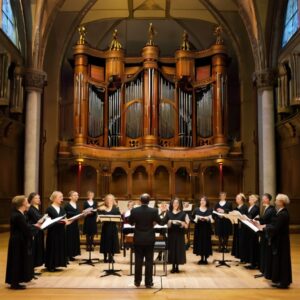Choral music didn’t just spring up out of nowhere; it has deep roots that stretch back to ancient civilizations. Think about ancient Greece: they were known for their theatrical productions, which often included a chorus. This chorus wasn’t just a bunch of people standing around singing, it played a crucial role in narrating the story and conveying the emotional undertones of the performance.
Gregorian Chants were monophonic, meaning they consisted of a single, unaccompanied vocal line. Sung by choirs of monks, these chants were meant to lift the spirits of worshippers and connect them to the divine. This form of singing laid the groundwork for future choral compositions. It’s awe-inspiring to think that the simple, unadorned melodies of Gregorian Chant eventually gave rise to the intricate, multi-voice arrangements that we have today.
 The Renaissance
The Renaissance
Fast forward to the Renaissance period, when choral music really started to blossom. You had composers like Josquin des Prez and Giovanni Pierluigi da Palestrina creating complex, polyphonic works that combined multiple independent vocal lines. This was a time when people were rediscovering the joys of harmony and counterpoint, and choirs provided the perfect medium for showcasing these intricate musical techniques.
Polyphony added depth and richness, creating a lush tapestry of sound. You could have sopranos soaring above with high, clear notes, while basses rumbled below with deep, resonant tones. The effect was mesmerizing, drawing listeners into a fuller, more immersive musical experience. This period truly cemented the choir’s role as both a communal and artistic force.
The Baroque Era
Enter the Baroque era, a time of grandeur and emotion in music. Think of Handel’s “Messiah” or Bach’s “Mass in B Minor.” These are compositions that, to this day, are considered monumental works of choral music. The Baroque era saw choirs taking on more ambitious pieces, often accompanied by full orchestras. This period was marked by an increase in dramatic expression and ornamentation—the music was meant to move people both spiritually and emotionally.
Take Johann Sebastian Bach, for instance. His works are considered some of the pinnacles of choral music. Composed with a deep understanding of both vocal and instrumental harmony, Bach’s choral compositions were technically brilliant and spiritually profound.
The Classical Period
Moving along to the Classical period, we encounter composers like Mozart and Haydn, who brought a new sense of elegance and balance to choral music. Their compositions often aimed for clarity and form, adhering to strict musical structures while still delivering emotional impact. Mozart’s “Requiem” and Haydn’s “The Creation” are prime examples of the period’s masterful choral works. These were pieces that blended sophistication with accessibility, allowing wider audiences to appreciate the beauty of choral music.
Mozart’s “Requiem,” though left incomplete at his death, stands as a testament to his genius. The choir is guiding the listener through expressions of sorrow and hope, light and shadow. Haydn’s “The Creation,” with its vivid depiction of the Genesis story, combines choral and orchestral forces to create an almost cinematic experience, long before the invention of film.
The Romantic Era
Picture a time when music started to break away from strict forms and instead focused more on expressing individual emotions and stories. Composers like Brahms, Verdi, and Dvořák pushed the boundaries of what choral music could do. They expanded the size of choirs and orchestras and infused their compositions with a greater range of dynamics and emotions.
Brahms’s “Ein Deutsches Requiem” is a beautiful example. Instead of sticking to the traditional Latin text, Brahms chose passages from the German Bible, creating a deeply personal and humanistic work. Giuseppe Verdi’s “Requiem,” often described as a “opera in ecclesiastical robes,” adds drama and intensity to the liturgical form, making it a favorite in both sacred and secular settings.
Antonín Dvořák’s “Stabat Mater” and “Requiem” evoke a raw, visceral emotional response. These compositions integrate elements of traditional folk music with classical structures, creating pieces with wide emotional range and accessibility. The choirs in these works play essential roles, conveying the deep sorrow and eventual solace intended by the composers.
Modern and Contemporary Choirs
Jumping to the 20th and 21st centuries, you’ll notice that choral music continued to evolve, adapting to the changing times and societal shifts. From the sacred music of the early 20th century to more experimental and avant-garde compositions, choirs have proven their versatility and enduring appeal.
Consider the works of Benjamin Britten, such as “War Requiem.” Written in the aftermath of World War II, this piece combines traditional Latin liturgical texts with war poetry by Wilfred Owen. The choir, along with soloists and orchestras, creates a haunting, poignant commentary on the brutality of war.
In contemporary times, composers like Eric Whitacre and Morten Lauridsen have captured the hearts of choral enthusiasts around the world. Whitacre’s “Virtual Choir” project, for example, tapped into modern technology, allowing singers from around the globe to perform together online. This creative innovation reflects how the choral tradition adapts to new cultural and technological landscapes.
Lauridsen’s choral works like “O Magnum Mysterium” bring a lush harmonic language and tender sensitivity to the forefront, captivating modern audiences and ensuring choral music continues to thrive.
The Role of Choirs in Culture and Community
Singing together in a choir can be a powerful communal activity, fostering a sense of unity and shared purpose. In historical contexts, choirs were often tied to religious institutions and community events, serving as a focal point for festive, ceremonial, and reflective occasions.
In many indigenous cultures, group singing forms part of traditional storytelling and rituals, underlining the integral role of communal voice in human culture. Folk choirs in countries like Bulgaria, Georgia, and South Africa have preserved unique styles of choral music that reflect their cultural narratives and identities.
The Composer’s Perspective
Composing is an art form that requires a deep understanding of vocal mechanics, textual expression, and harmonious balance. Every composer knows that the human voice brings a unique emotional quality that instrumental music often can’t match.
When writing for choirs, composers usually consider a range of factors to effectively communicate their musical ideas. Text selection is an important aspect.; the words must resonate with the intended emotional depth and cultural significance. Then comes the arrangement of vocal parts—sopranos, altos, tenors, and basses—with each part designed to complement the others while standing strong on its own.
Consider Ralph Vaughan Williams’ “Dona Nobis Pacem”, which masterfully combines texts from the Latin Mass, biblical verses, and poetry by Walt Whitman. This eclectic text selection helps to deepen the emotional and thematic reach of the composition, highlighting various aspects of peace against the backdrop of war.
A skilled composer can also infuse their work with distinctive traits or nuances that reflect their cultural heritage. Arvo Pärt, an Estonian composer, employs a minimalist style he calls “tintinnabuli,” which is deeply influenced by his Eastern Orthodox faith. His choral works are marked by their simplicity and spiritual intensity, creating a profound listening experience.
